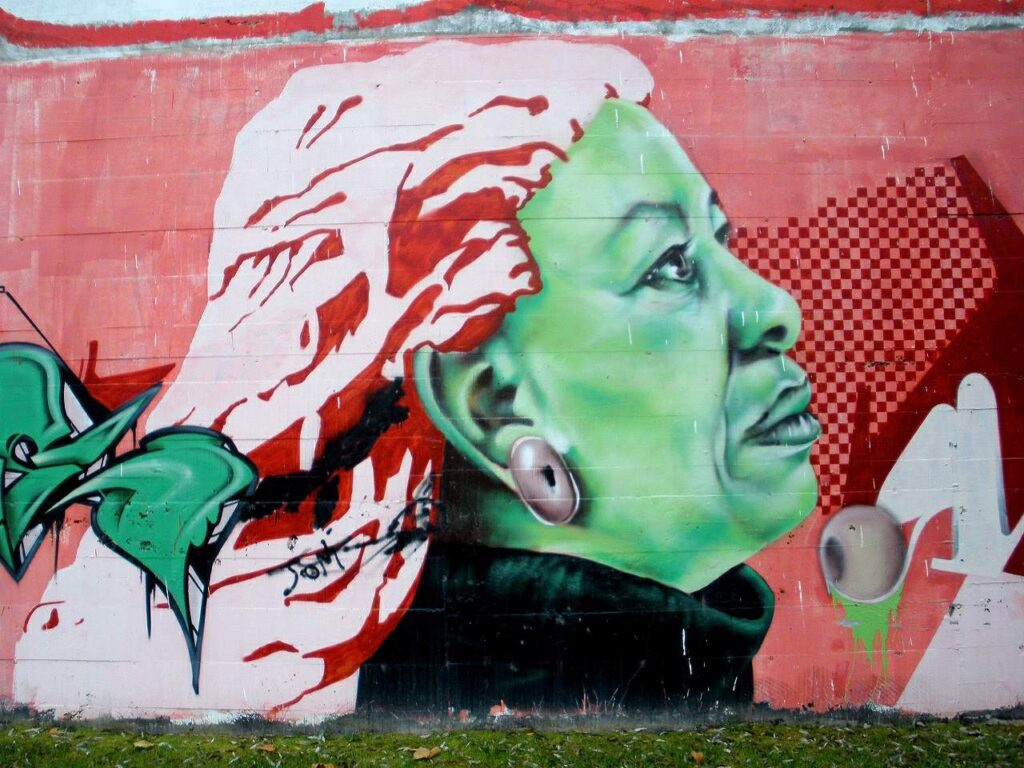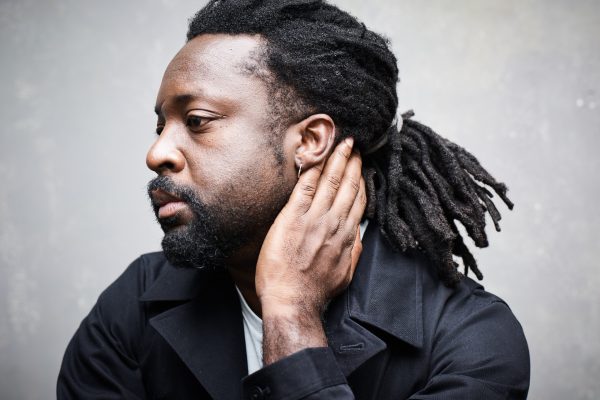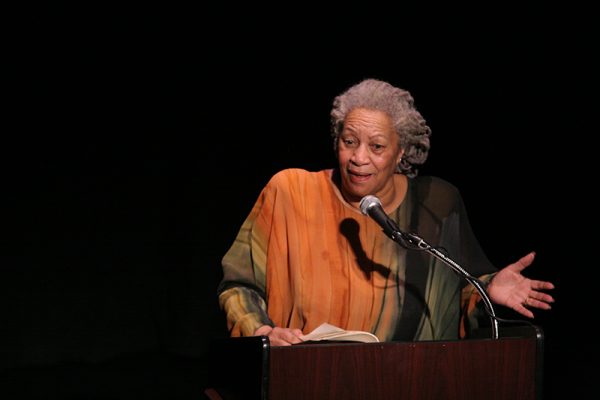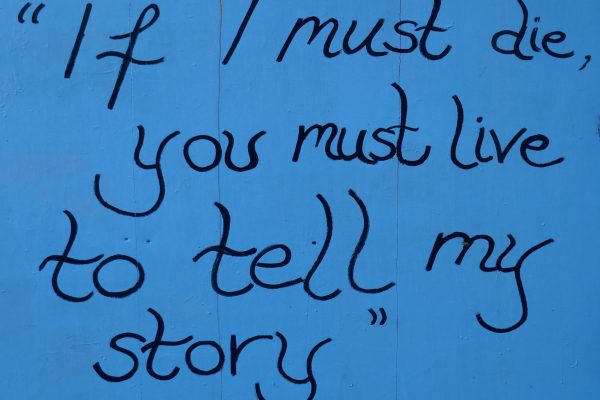It was at a summer cookout that I recall first seeing the scars, dark brown, raised, and thick, that poured down Uncle Pitt’s back. He sat on a folding chair, laughing. He laughed a lot, and occasionally danced, grabbing my mother’s hand and twirling with her in what seemed to me an old-fashioned partner dance. Having been raised as a proper Black child, I neither stared nor pointed, but I was transfixed by the scars and kept the image at the forefront of my mind until I could ask my mother about them. “Mommy, what is that on Uncle Pitt’s back? Is he hurt?” She responded, “No, he is fine. See how happy he is?”
Later she told me that sometimes when people were imprisoned, scientists and doctors conducted experiments on them in exchange for things like cigarettes. Uncle Pitt had been “experimented on.” She said this as a matter of fact, if with a tinge of sadness. She said it in that same tone she used whenever she had to reveal something harsh. It was as if the tone would soften the blow of the knowledge she revealed.
This essay is featured in Repair.
I knew Uncle Pitt had been incarcerated. Aunt Eartha wrote letters to him and to her oldest son, who was in the military. On our side of the family, each generation had at least one young man who had “done time” and at least one who went to the military. My maternal grandfather served in the military. Daddy was in the Navy and later did four months for drug possession, before I was born. Uncle Pitt had been in the Army. Of my male cousins, one had done a little time for gang fighting with a BB gun; his brother had gone to Vietnam. Of my two nephews, one served time for manslaughter before he turned twenty and the other went into the Air Force right out of high school. All of them, whether on the right side or wrong side of the law, had encounters with the police, who stopped and questioned, sometimes harassed, and at least once brutally beat them. It was a hated but almost expected occurrence in our lives. At any given time, we were helping fund someone’s bail, or offering support at court, paying lawyers and bail bondsmen, receiving and writing letters to our loved ones there. That was the plight of our men. None of them spoke to the women or children about their time in prison. I hope they spoke to each other.
As a girl, I knew that men I loved sometimes ended up in prison. I knew that some of them might have done something to be there, but incarceration didn’t have to be an indication of guilt. There were many innocents behind bars. Interestingly, though we all knew someone who had done or was doing time, we also knew that many of our neighbors who had been victims of crime rarely even bothered to call the police.
If I was haunted by the sight of Uncle Pitt’s scars, other incidents haunted me more: the frequent occurrences of sexual assault, including gang rape. When such instances transpired, families rarely called the police. They feared girls would be further victimized by them and were almost certain her assailant would not be convicted.
Although the failure to report sexual crimes was presented as an effort to protect the victim, I also understood it as a failure to fully value the lives of Black girls. I believed one of the only things standing between me and such victimization was the protection of the men in my family. If I had been assaulted, I assume but am not sure my family would have called the police; they too doubted the ability or willingness of the police to deliver justice. However, this I knew, deep in my bones: if my assailant were known to my family, he would have been maimed or murdered.
In her first memoir, I Know Why the Caged Bird Sings, Maya Angelou reveals that in all likelihood, her uncles murdered the man who molested her as a girl. Although separated by time and location, I recognized that moment as one that could have been mirrored in my own life. In the world in which I was raised, prisons rarely offered rehabilitation and courts did not serve justice. Whites didn’t do time for harming Blacks; Blacks were unjustly imprisoned. Justice as we understood it was Divine—God would take care of it; or it was retributive, meted out by gangs, friends, and family members.
What is the nature and possibility of justice for the crimes of racism, slavery, segregation, and mass incarceration that Black people have experienced in the United States? What does justice look like for centuries of systemic abuse and violence enacted by a society built upon withholding justice from Black people? In all of her novels Toni Morrison contemplates the nature and practice of justice.
Throughout Song of Solomon (1977), Morrison explores the meaning of and quest for justice. She is especially interested in the nature of justice and its relationship to vengeance and history, retribution and repair. Significantly, most of the discussions about justice take place between the novel’s men. The first and most explicit discussion occurs in the barbershop. The narrator tells us:
A young Negro boy had been found stomped to death in Sunflower County, Mississippi. There were no questions about who stomped him—his murderers had boasted freely—and there were no questions about the motive. The boy had whistled at some white woman, refused to deny he had slept with others and was a Northerner visiting the South. His name was Till.
The statement does a great deal of work. It declares the matter-of-factness of the murder. It is spoken like it might be a common occurrence. There is no mystery to be solved. The culprits are known. They feel neither remorse nor guilt. They do not fear arrest, trial, or conviction. The dialogue that follows occurs in the shadow of Emmett Till’s murder in August 1955. Till is the Black fourteen-year-old from Chicago who is falsely accused of molesting a white woman whose husband and brother-in-law then brutally murder him. The conversation that ensues illustrates the diversity of opinion and ideology in the Black community. The more conservative speaker almost blames the teenager for provoking his own death. His open defiance of the rules governing contact between Black men and white women constitutes a refusal to stay within the confines that the Jim Crow South sets for Black people. Another man counters by noting that Till was murdered for daring to act like a man.
No matter their politics, each man in the barbershop knows that his Black skin constitutes guilt in the eyes of whites and that they are all vulnerable to any white vigilante without recourse to justice. The very arbitrariness of white power is what makes it so frightening. At any given time, in any given place, they too might share Till’s fate.
Guitar, a militant young Black man, member of a vigilante group that seeks eye-for-an-eye justice, articulates an argument based on the historical truth of justice denied. He says:
We poor people, Milkman. I work at an auto plant. The rest of us barely eke out a living. Where’s the money, the state, the country to finance our justice? You say Jews try their catches in a court. Do we have a court? Is there one courthouse in one city in the country where a jury would convict them? There are places right now where a Negro still can’t testify against a white man. Where the judge, the jury, the court, are legally bound to ignore anything a Negro has to say. What that means is that a Black man is a victim of a crime only when a white man says he is.
In an era when the murderers of too many Black Americans walk free, readers will feel the ongoing truth of Guitar’s assertion. Morrison demonstrates the persistence of injustice through time and place, past and present, North and South. The only justice Morrison’s male characters can imagine is vengeance. Most advocate survival over revenge; in so doing they forgo seeking justice.
Morrison offers another possibility through Circe, a midwife and servant who lives in the ruins of a plantation mansion once owned by a white family, the Butlers. Circe is the subversive agent who undermines everything her white employers lived and died for. She is over 100 years old, and her face is a map of wrinkles. After the murder of protagonist Milkman’s paternal grandfather, Macon Dead Sr., Circe rescues, hides, and takes care of his two children. She takes from the Butler’s wealth, made by slavery and then by stealing the land of freedmen, to care for the orphaned children of one of their victims. She feeds them, provides them shelter and love, hides them from harm, and sends them on their way. Their problem becomes her problem. She enacts an ethic of care that helps ensure their well-being and their ability to become self-sufficient.
Morrison’s Circe, like Homer’s, serves as Milkman’s escort, and guide to the spirits of the dead . . . in that she guides him to seek his family’s history and, consequently, his own identity. She is a healer, nurturer, and protector, but she is also a justice seeker. She helps to bring a long-term sense of justice into being. It is not justice for those who were the immediate recipients of harm, nor does it punish those who have caused the harm. But it helps to create a more just society for the progeny of both.
With their large columned mansion, the Butlers laid claim to a classical past, but Morrison assures us it is the enslaved whose roots are more ancient than Eden and whose progeny reach into the present (though perhaps not into the future). Western democracies like the United States claim a cultural, philosophical, and political lineage that links them to the ancient Greeks and Romans. Through Circe, Morrison reminds us that those ancient civilizations were also slave societies. In Morrison’s hands the progeny of the enslaved and their quest for justice outlast the material wealth that their labor helped to create. The grand plantation, an ode to temples of the past, is now, like those of the ancient world, a ruin.
There will be no romantic plantation tours at the Butler place. Circe does not act out of a love of whiteness, nor out of loyalty. Neither does she act out of revenge. She lives with a patient sense of justice, a kind of divine retribution, and for the return of the Black son. She gains pleasure not by killing the Butlers, but by watching their monument to history and greed decay from within and bearing witness to its ruin. As Circe explains: “They [the Butlers] loved this place. Loved it. . . . Stole for it, lied for it, killed for it. But I’m the one left. Me and the dogs. . . . Everything in this world they lived for will crumble and rot.” What doesn’t rot on its own, she will allow the dogs to destroy. “Ha! And I want to see it all go, make sure it does go, and that nobody fixes it up.”
Through Circe, Morrison juxtaposes the Odyssey’s version of the Quest narrative with a quest that will yield a suppressed history, narrate the lives of those who have been victims of the West, and thoroughly question the patriarchy by insisting on a reconstructed masculinity at quest’s end.
In Song of Solomon, Morrison explores the potential of retributive justice, which she rejects in favor of a long-term divine justice toward which the universe bends. In Home (2012), however, Morrison turns most fully to the potential of restorative justice to be a guiding principle of a society governed by an ethic of care. There is nothing that can make up for the crimes against her victimized characters. In her model, the offender is not reconciled with the victim, but the victim is cared for and embraced by the community. And witnessing this, the victim’s brother, who in another instance has been an offender, must come to terms with the trauma he has caused and do something ethically productive. As a result, at novel’s end a victim and a victimizer are transformed.
Set in the 1950s United States, Home is the story Frank Money, an African American veteran traumatized by his experiences in the Korean War, who receives word that his younger sister Cee is in harm’s way in Georgia, and sets out to rescue her. Cee has been working as a domestic servant for a white doctor, Beauregard Scott. Unbeknownst to Cee, Scott is a eugenicist who “occasionally performed abortions on society ladies,” and set out to improve the speculum, mutilating a number of poor Black women in the process. Cee quickly becomes victim to Scott’s experimentation.
Frank carries his sister in his arms until they can hire a hack to take them to the small town of their childhood, Lotus. There he hands her over to Miss Ethel and a band of local women, who set out to heal her. At no point does anyone call the police, nor do they issue a complaint to a medical board. These are not options that will do Cee any good, since they won’t render justice to her.
First, they tend to her bodily wounds. The women take turns providing her medicinal herbs and potions. Cee’s healing includes being “sun-smacked, which meant spending at least one hour a day with her legs spread open to the blazing sun.” The women believe access to the sun’s healing powers provides “a permanent cure. The kind beyond human power.”
The ten days exposed to the sun is a ritual, an absorption of energy to combat evil and harm. At the end of two months in their care, “Cee was different.” These women confront illness as an enemy they must vanquish. Their care is without sentiment, and it certainly holds no pity. As Cee heals from their potions and food, they bring her embroidery and crocheting to do and finally, when she’s ready, they invite her into their quilting circle. Finally, when she is healed to their liking, Miss Ethel tells her:
Look to yourself. You free. Nothing and nobody is obliged to save you but you. Seed your own land. You young and a woman and there’s serious limitation in both, but you a person too. Don’t let . . . some trifling boyfriend and certainly no devil doctor decide who you are. That’s slavery. Somewhere inside you is that free person I’m talking about. Locate her and let her do some good in the world.
Freedom lies not in her social condition but in her self-perception. She must understand herself to be a self-reliant, self-possessed grown woman before she can fully enter, as an equal, the community of women who cared for and healed her. She must have a sense of herself beyond her victimization so as never again to give herself over to those who would further victimize her. Freedom here is a mental state, one that she must claim for herself.
Morrison identifies the women’s work to heal Cee as an “instance of innate group compassion.” The women’s ethic of care gives Cee herself, transformed, wounded but standing strong. Like many Black and poor women in the South, she has been sterilized by a doctor without her knowledge and consent. She carries the burden of that loss within her, and yet she leaves the women stronger, economically self-sufficient (she sells her quilts to visiting tourists), and no longer in need of her brother’s rescuing:
Frank didn’t know what took place during those weeks at Miss Ethel’s house surrounded by those women with seen-it-all eyes. . . . They delivered unto him a Cee who would never again need his hand over her eyes or his arms to stop her murmuring bones.
In Home, there can be no justice for what Dr. Scott has taken from Cee, especially as it is unlikely that what he did to her even counted as a crime. In her recent work Intimate Justice: The Black Female Body and the Body Politic, political theorist Shatema Threadcraft reminds us that Black women who suffered forced sterilization at the hands of the state are largely responsible for the shift in feminist language from a right to abortion to “reproductive rights.” So pervasive was this practice that it became commonplace and was nicknamed a “Mississippi appendectomy.” And it was legal. Threadcraft wonders “What, in this instance, does justice require?” The project of intimate justice, she writes, “is still incomplete.”
There is no movement demanding justice for Cee, just a community of women, who heal her wounds, teach her how to incorporate her physical and emotional scars into the woman she has become, and send her off to fulfill her purpose to do some good in the world. They model a kind of behavior and ethical practice that lays the foundation for her transformation. They do not invite her victimizer into the restorative justice process or into their community. And yet, their community offers healing to those who have victimized others. As we learn, part of Frank’s mental trauma is a result of his own horrific action during his time in Korea. He is broken from the guilt he bears. Returning to Lotus to rescue his sister, restores him as well. Before returning home, he sees the world in black and white, but once he has delivered his sister, he notices “It was so bright, brighter than he remembered.” He notes “marigolds, nasturtiums, dahlias. Crimson, purple, pink, and China blue. Had these trees always been this deep, deep green?” Clarity and an appreciation for the world’s beauty return to him after he acts out of love to save his sister.
Morrison has suggested that the very act of putting stories of suffering on display is necessary to acquire justice. Restorative justice seeks to offer repair, to put things as they should be. Many progressive thinkers and activists have argued for restorative justice to replace the punitive paradigm, which governs so much of American society. Others are beginning to turn from restoration to transformation. Activist and scholar Zaheer Ali writes:
If things are restored back to the way they used to be, the same arrangements of power, the same relationships, the same mindsets, etc., is that really justice? But if we think about *transformative justice* as a means by which to create a space that allows people to exercise agency to make new (and better) decisions in their lives—maybe that is closer to justice.
The novel can raise questions about the possibilities and goals of justice. It allows us to imagine what a society governed by an ethic of care, devoted to restoring and repairing those who have been harmed, giving them the space for transformation, might look like. It is not easy, it does not offer the possibility of a cure, but it encourages healing. The scar is still there. It becomes a part of the new person, who is hurt but not broken. As such she can go on living a productive life devoted to goodness and breaking a cycle of harm.
In an interview, activist and philosopher Angela Davis says: “I think that restorative justice is a really important dimension of the process of living the way we want to live in the future. (…) We have to begin that process of creating the society we want to inhabit right now.” This, I think, is the work of the novel, especially in Morrison’s hands. Her late fiction imagines worlds that were, and in so doing, provides a template for what might be. Interestingly in Morrison’s case, achieving justice is secondary to the acquisition of self-knowledge. She asserts that “a satisfactory or good ending for me is when the protagonist learns something vital and morally insightful that she or he did not know at the beginning.” I wonder if the acquisition of self-kinowledge might not be the result of a process of restorative justice.
By novel’s end, Frank and Cee stand like the tree with which Morrison closes the novel, a sweet bay tree with olive-green leaves, “hurt right down the middle.” This image, of the tree, scarred but not broken, sustains me. I hold on to the possibility of communal love and care in the ongoing struggle for justice. I hold on to it even amid ongoing trauma, in large part because I have been the beneficiary of transformative care. It is this love for those denied justice that motivates us to continue to seek it. Our movements hold the victims of injustice dear, say their names, weep for them and struggle to hold those who caused them harm responsible, to transform the society that allowed for their victimization. The theologian Serene Jones writes, “Mercy grants freedom from the bondage of harms. Justice is the struggle to make sure those harms stop.”
The struggle for justice is ongoing. In the meantime, we work to heal, love, and transform ourselves and the world we live into a more just place.
Editors’ Note: This essay was adapted from Farah Jasmine Griffin’s forthcoming book, Read Until You Understand, published by W.W. Norton.





